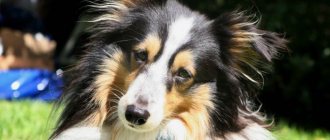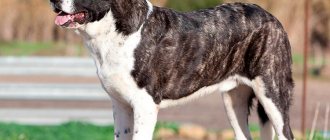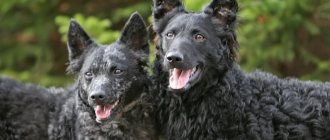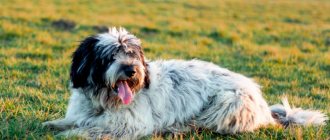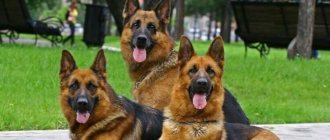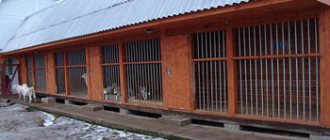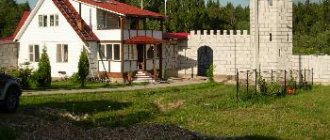The Estrella Sheepdog is an ancient breed with an interesting history, also known as the Portuguese Mountain Shepherd. He has excellent health, special endurance, is physically developed, intelligent and attractive in appearance. In their historical homeland, Portugal, they have the status of pride and national treasure and are still popular among the population.
In Europe and the countries of the former CIS, it is quite problematic to meet such representatives, and among dog breeders from the Russian Federation they are generally rare. The animal is truly amazing, has wonderful character traits and does not skimp on care and feeding.
Origin story
It is believed that this is a historically established breed that existed on the territory of modern Portugal during the times of Ancient Rome, it was capable of performing many functions that were necessary for humans. Then people fed from the herd and did not have the opportunity to reliably fortify their estates from robbers and wild animals. This is where the Estrela Shepherd dog, also called:
- Estrela mountain dog;
- Portuguese Shepherd;
- cao da serra da estrela.
There is an opinion that it has roots associated with the Spanish Mastiff, but there is no official confirmation.
For a long time, the breed was not in great demand in mountainous areas, in pastures and in other similar areas; the Portuguese preferred foreign dogs. This happened until dogs began to regularly win competitions at the beginning of the 20th century. The Estrela Shepherd Dog was then recognized and had a standard in 1934, and professional breeding began only in the mid-twentieth century. Pets had unique physical abilities, formed over centuries as a result of survival in the wild.
Character
Portuguese Shepherds, as already mentioned, have a calm, friendly character . They are very loyal to their owner and have proven themselves to be excellent, loyal guards.
Portuguese Shepherds also treat children well and are happy to allow children to play with them.
Dogs of this breed are determined, curious, active, mobile, and do not like to sit still. They are distrustful and wary of strangers, because their main task is to protect their owner.
As for training, Portuguese Shepherds lend themselves well to it, since they are considered one of the smartest dog breeds.
To achieve the best results in learning new commands, it is advisable for the trainer to show strength of character and perseverance.
Shepherds love attention and affection from their owner and even need it. They are sociable and loneliness is not for them. At the same time, they do not bark for no reason (more silent ones), but make a sound in the process of work or as a response to the actions of others.
Description of the breed
This pet is somewhat different from the usual version of the dog, since its body is slightly longer than usual.
| Appearance | Characteristics |
| Head | Somewhat prominent, wide, with a convex skull. But the muzzle has an elongated shape, which tapers closer to the tip of the nose. |
| Ears | Long, triangular, hanging. |
| Eyes | Not a remarkable shape, but amber in color. |
| Nose | Usually available in the same color as the base coat, but ideally it is jet black. |
| Tail | Not short, but not too long, has a crescent shape. In a relaxed state it hangs freely, and when tense or running it becomes higher than the body. |
| Eyes | Not a remarkable shape, but amber in color. |
| Wool | Medium length, characterized by rigidity, sometimes the coat is smooth. |
| Color | Usually wolf or with brown tints, but also fawn, brindle, and grayish-yellow. If another option or combination is observed, then the breed cannot be called pure. |
In general, such a shepherd, if you give it a psychological portrait, is relatively calm and active. She has no outbursts of anger towards those whom she recognizes as her own. Only she still has character, she strives to be a leader. Therefore, when a new owner takes a puppy or an adult, he must show her who is the leader among them.
Caring for your Portuguese
Estrel Shepherds require careful grooming. Your pet needs to be thoroughly brushed twice a week. During the molting period, use a special powder brush daily. Some owners allow the wool to be "in the socks."
- Teeth: either brush them with a special brush or take them to the dentist. For the rest of your dog's life, give him special bones and treats designed to clean plaque from his teeth. Available in veterinary stores.
- Bathing: As needed, not too often. Usually four to five times a year is enough, depending on the degree of skin contamination. Do not let the skin dry, but dry it with a soft towel. Wash your paws thoroughly after every walk, as a lot of dirt and debris accumulate on them.
- Eyes: Remove excess discharge with eye wash, chamomile or a mild infusion.
- Nails: Trim your pony's nails once or twice a month with a trimmer and teach them to do so from an early age.
- Ears: Wax should definitely be cleaned, but avoid damage and excess wax in the ears. A warm solution and a cotton swab will help you cope with the task.
- Parasites: Remove fleas and ticks regularly. Administer anthelmintics, get vaccinations and immunizations on schedule, and don’t skip them.
Visit your veterinarian regularly for checkups. If there is a change in behavior or bad breath, consult a doctor.
Pros and cons of the breed
- Attentive and persistent security guard
- A true loyal friend
- A great companion
- Able to accompany children
- Easily survives almost any weather, as it is designed to live outdoors
- Gets along easily with other animals she is used to
- Smart and adaptable, she has no difficulty learning new things
- Rarely gets sick, requires minimal care
- In some cases, there is an overly aggressive attitude towards strangers
- It can be difficult to find for purchase or breeding, rare
- Can't live in an apartment
Nicknames
The variety of names and nicknames for dogs is amazing. The most common names for Portuguese Shepherds are:
- Xanthe.
- Zarna.
- Milos.
- Grant.
- Gabi.
- Neira.
- Cortez.
- Let's take it.
- Veit.
The cost of a puppy of this breed varies from 2 to 3 thousand dollars .
The Portuguese Shepherd is a smart, beautiful, loyal dog. She combines a set of the best qualities and over more than a century of existence has proven herself to be a reliable companion and a brave guard. Not being picky and open-minded has made Portuguese Shepherds indispensable helpers.
Breed Features
The Estrela Shepherd Dog is particularly distrustful of strangers; sometimes it is overly aggressive with those it does not know. But a properly raised dog will not make unnecessary movements if it is properly trained and tamed. These qualities are capable of saving the life and property of the owners, and for them this breed is a real find, because the loyalty of such a pet is limitless.
This dog will not live indoors, it is extremely vigilant and will not let anyone in from outside the area it considers its home. In such conditions, she feels freedom, satisfaction and a sense of control over what is happening, which is required of a true leader.
Content
It is not suitable for storage in a small room in a city apartment. Ideal conditions - a house in a rural area with freedom of movement. A heated enclosure would be a good choice.
- Regular walks in the morning and evening, long walks.
- The dog must have a fence, otherwise it will consider the entire territory to be its own.
- In winter it is better to bring it indoors.
Nutrition
Not all large dogs eat really a lot, this also applies to the Estrela Shepherd, who prefers regular meals to support the body under serious stress. After all, her physique is rather sinewy, strong, with a minimal proportion of body fat. Therefore, the dog eats twice a day in medium portions, which must include:
- About half protein.
- Zlakov.
- Complex of vitamins and minerals.
Usually, in order not to make a mistake, the owners buy professional food for their animal and give it once a day, the rest is at their own discretion.
Raising chickens
Taking into account the impossibility of breeding chickens of the Hercules breed “in itself”, there is no question of the correct selection of producers in this case. But due to the large distances, many buyers prefer to take the egg and hatch Hercules chickens in their own home incubators. Therefore, the issue of raising chickens is very relevant.
With proper transportation, 80-90% of chickens hatch from purchased eggs. In the first days the brooder should be 30°C. Gradually the temperature is reduced to normal street temperature. Due to their rapid growth, chickens require large amounts of high-protein feed. If it is not possible to use specialized starter feed, chickens should be given a finely chopped boiled egg. Chopped greens must be included in the food. Some people prefer to give green onions, believing that they disinfect the intestines. But there is still nothing to disinfect the gastrointestinal tract of freshly hatched chickens. Therefore, you can give chopped parsley with the same success. If you're not too lazy, you can cut grass picked from the street.
Cereals provide a large amount of carbohydrates, but have very little protein. If you feed chickens with crushed grains, including corn, then you must add meat and bone meal to the diet.
Legumes are also suitable for providing protein. You can buy alfalfa meal at pet stores. Alfalfa contains a significant amount of protein and can replace peas or soybeans.
Health
Although this breed is considered particularly strong and hardy, it has vulnerabilities that should be taken into account when caring for the dog’s health. He is constantly on the street, where many unsafe surprises await him, so you need to vaccinate your pet according to the veterinarian’s recommendations. And also such a dog has a predisposition to certain diseases at the genetic level, this applies to:
- Hip dysplasia.
- Skin diseases, especially after frosts when the integument freezes, after heat, when the dermis under the fur gets warm. Sometimes due to stress there can be rashes.
- Cardiomyopathies.
- Volvulus (features of the gastrointestinal tract).
Most of these potential problems can be solved through a competent approach to caring for your pet.
Training, training
To make the training process easy, it is necessary to show strength of character. Dogs are distinguished by their hard work, lively mind and quick wit, but can show love of freedom and pride. Try to establish rapport with your pet from the very beginning.
When training, take into account the animal's mobility and energy. This breed will happily accept long-distance steeplechase training.
Be sure to read:
- Appenzeller Mountain Dog - decoration of a private home and the pride of the owner
- The Puli dog is a woolly shepherd and a reliable guard
- English Staffordshire Bull Terrier - the best nanny for children
Breeding
With the breeding of representatives of the Estrela Shepherd Dog breed, there are questions directly related to the non-prevalence of pure representatives. Before agreeing on a litter, you need to make sure that the dog on the other side meets the standard. But this can rarely be found outside the Portuguese border, so if questions arise about the availability of a photo, you should be especially careful.
To find reliable representatives of the breed, it is recommended to contact those who breed these pets in Portugal. It is there that the concentration is greater than in any other country, and the purity of the breed is more likely.
Appearance
This dog breed has the following appearance:
- Average height (about 45–55 centimeters).
- Weight varies from 17 to 27 kilograms.
- With shaggy, long and straight (sometimes slightly wavy) coat.
- Due to its color (most often white-black, brown-black, brown-white, gray-black or gray-brown), the Portuguese Shepherd appears to have a mustache and beard on its face.
- The body has a slightly elongated shape.
- The head of Portuguese Shepherds is wide and large.
- A characteristic difference is the slightly upturned nose, on which the nostrils stand out well.
The forehead is clearly defined, rectangular. Portuguese Shepherds have round eyes with black rims. The ears are not very large, hanging. The chest is wide and strong.
Since these dogs love activity, their paws are strong, with well-developed muscles. The pads of the fingers are thick to make running easier. The tail is small, droops down, but in moments of emotional activity (from joy, during games) it is raised up. The age range of life ranges on average from 12 to 17 years.
Main diseases and problems
Diseases of this type of dog mainly depend on the quality of care and the individual degree of susceptibility to specific diseases. Typically, the health of this species does not involve difficulties in maintaining and frequent problems, because from time immemorial it has been running and frolicking in the open air. Although an incorrectly bred breed may pose dangers such as an unforeseen imbalance in vulnerability to disease.
You just need to periodically check your pet for ailments such as:
- Clogged ears.
- Eye discharge or inflammation.
- Dysplasia of the hip joint.
- Digestive problems, abdominal pain that can lead to volvulus.
- Fatigue too quickly, decreased activity, which can indicate heart problems.
Having a dog in the house can protect owners from asthma and colds
Research shows that children who lived in households with dogs had fewer allergies and were less likely to get sick than children who were raised in households without pets.
In the Middle Ages, dogs were accused of witchcraft
In the Middle Ages, dogs were often tortured and punished along with their owners. There is a known case, for example, that a dog was hanged in the city of Salem in the territory of modern Massachusetts in 1692 for witchcraft.
A dog is the first animal to orbit the Earth
Laika became the first living creature to orbit the Earth. Her flight on Sputnik 2 took place in 1957. Although she herself died during the flight, her daughter, Pushinka, gave birth to 4 puppies from the terrier Charlie, whose owner was US President John F. Kennedy.
Historical reference
The breed is well known and popular in its homeland and is almost unknown in the wider world. The Portuguese Mountain Shepherd is a dog of ancient origin, whose history is shrouded in myths and folk versions. It is known that the bone structure of the Estrela Shepherd Dog is very similar to the ancient herding and guard dogs of Portugal. The exact age of the group is unknown. Dogs most likely came to Portugal during the dawn of Ancient Rome. As you know, Molossians served in the Roman army. There is no written or other factual confirmation of this version, but this particular story seems logical.
The Estrela Shepherd is naturally formed, which gives the breed endurance. The breed was bred to suit the needs of the local population, climate, landscape, pace of life, etc. The uniformity of the livestock is ensured by the fact that there were simply no more hardy and hard-working dogs on the territory.
Pedigree breeding of Portuguese Mountain Shepherds was so conserved that even in the 20th century the existence of the breed (outside Portugal) was known only by hearsay. The indigenous population of Portugal valued endurance and dedication to work, but exhibitions and shows were considered a whim and the lot of “refined foreign breeds.”
The first shepherd dog was shown in the big world only in 1908. Several fans of the breed brought their favorites to see their working qualities. The Estrela Shepherd Dog was shown working with herds of cattle and what was seen greatly impressed both the judges and the audience.
Over the next 10 years, Portuguese Mountain Dogs became regular competitors. It’s interesting that the conditions for victory became more and more tough, but the four-legged animals completed the tasks with ease every time.
In 1922, a black version of the breed standard was developed in Portugal, which was approved after complete stabilization of the exterior. In the first version of the standard, very important breed characteristics were missed, which set pedigree breeding back several steps. Thanks to enthusiasts who spared no effort, no money, no time on educational work, a more complete standard was created.
Since the 1950s, professionals have taken up the breeding of Estrela Shepherd Dogs, who were concerned not only with the practical side of the issue, but also with the uniformity of the livestock. Representatives of the breed group began to appear frequently at shows, and since the appearance of the dogs is truly impressive, this fueled the interest of experts and the public.
Upbringing
Socialization takes place quickly, but it begins from a very early age. Start with simple training to use a collar, take him out to noisy places, and give him the opportunity to interact with other animals.
Do not shout, rush your pet, or use force. The better you show yourself during educational measures, the faster the puppy will recognize your superiority. If you do not have experience raising large dogs, contact a specialist in advance.
He may be stubborn, you should not give in to provocation, it is better to show persistence, then he will understand that the manipulation will not work and he will have to obey.
An excellent option would be to go through one of the programs with a specialist, after all, this is a working dog, this will only benefit her. And a person will be able to understand all the features of building a relationship with a Portuguese faster.
An excerpt characterizing the Portuguese Shepherd
On May 29, Napoleon left Dresden, where he stayed for three weeks, surrounded by a court composed of princes, dukes, kings and even one emperor. Before leaving, Napoleon treated the princes, kings and emperor who deserved it, scolded the kings and princes with whom he was not entirely pleased, presented the Empress of Austria with his own, that is, pearls and diamonds taken from other kings, and, tenderly hugging Empress Maria Louise, as his historian says, he left her saddened by the separation, which she - this Marie Louise, who was considered his wife, despite the fact that another wife remained in Paris - seemed unable to bear. Despite the fact that diplomats still firmly believed in the possibility of peace and worked hard for this purpose, despite the fact that Emperor Napoleon himself wrote a letter to Emperor Alexander, calling him Monsieur mon frere and sincerely assuring that he does not want war and that there will always be to love and respect him - he rode to the army and gave new orders at each station, with the goal of hastening the movement of the army from west to east. He rode in a road carriage drawn by six, surrounded by pages, adjutants and an escort, along the highway to Posen, Thorn, Danzig and Konigsberg. In each of these cities, thousands of people greeted him with awe and delight. The army moved from west to east, and the variable gears carried him there. On June 10, he caught up with the army and spent the night in the Vilkovysy forest, in an apartment prepared for him, on the estate of a Polish count. The next day, Napoleon, having overtaken the army, drove up to the Neman in a carriage and, in order to inspect the area of the crossing, changed into a Polish uniform and went ashore. Seeing on the other side the Cossacks (les Cosaques) and the spreading steppes (les Steppes), in the middle of which was Moscou la ville sainte, the capital of that similar Scythian state where Alexander the Great went, Napoleon, unexpectedly for everyone and disgusting as a strategic one, and for diplomatic reasons, he ordered an offensive, and the next day his troops began to cross the Neman. On the 12th, early in the morning, he left the tent, pitched that day on the steep left bank of the Neman, and looked through the telescope at the streams of his troops emerging from the Vilkovyssky forest, spilling over three bridges built on the Neman. The troops knew about the presence of the emperor, looked for him with their eyes, and when they found a figure in a frock coat and hat separated from his retinue on the mountain in front of the tent, they threw their caps up and shouted: “Vive l'Empereur! - and one after another, without becoming exhausted, they flowed out, they all flowed out of the huge forest that had hidden them until now and, upset, crossed over three bridges to the other side.
